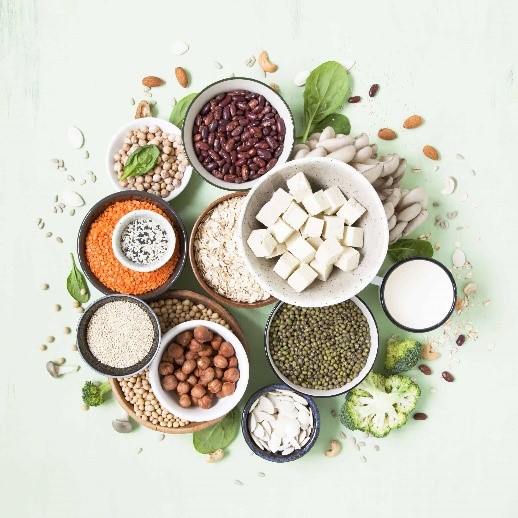“Where do you get your protein?” is a question people who are on or are considering a plant-based or vegetarian diet often hear. With a bit of creativity, there are plenty of sources and ways to consume an adequate amount of protein without eating meat.
Vegan and Vegetarian Sources of Protein
Vegan diets only include entirely plant-based proteins. Vegetarians don’t eat meat, but some do include proteins produced by animals like eggs, cheese, and milk, and this group is called ovo-lacto-vegetarians. The subset of vegetarians who choose to eat fish are called pescatarians. Below are a few common sources of protein for vegans and vegetarians and the amount of protein they contain:
| Food | Serving Size | Average Amount of Protein* | Vegan or Vegetarian? |
| Almonds | ¼ cup (one handful) | 6 grams | both |
| Pumpkin Seeds | ¼ cup | 9 grams | both |
| Black Beans | ½ cup, cooked | 8 grams | both |
| Tempeh | ¾ cup | 13 grams | both |
| Quinoa | ½ cup | 4.5 grams | both |
| Tofu | ½ cup | 28 grams | both |
| Eggs | 1 large egg | 6.3 grams | Vegetarian |
| Salmon | 3 oz | 18.79 grams | Pescatarian |
*For reference, it is recommended that the average, sedentary adult consumes 50-60 grams of protein per day. However, this amount varies based on activity level.
Protein Complementation
Animal proteins contain all nine essential amino acids our body needs to function and are known as “complete proteins.” Most plant-based protein sources do not contain all nine essential amino acids and are considered “incomplete proteins.” It is important to ensure that you are consuming the nine essential amino acids in your diet because they are the only amino acids that your body cannot synthesize on its own! Therefore, protein complementation —combining two foods that together have all nine essential amino acids—is a tactic that those eating a plant-based or vegetarian diet should practice. One may contain four of the essential amino acids our body needs while the other food contains the additional five. Here are some examples:
- Tofu or tempeh with brown rice or quinoa
- Bean soup with crackers
- Pasta with peas
- Peanut butter sandwich on whole-grain bread
- Salads made with beans and nuts or seeds
- Corn chips with bean dip

Finding delicious protein combos that you enjoy is all part of the fun! To get started, visit eatwell.colostate.edu or schedule a free appointment with Housing & Dining Services’ Dietitian Nutritionist to talk about eating a healthy and balanced vegetarian or vegan diet while in college.